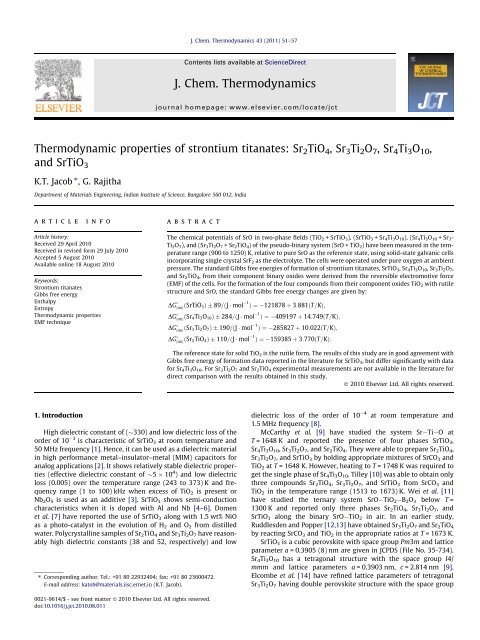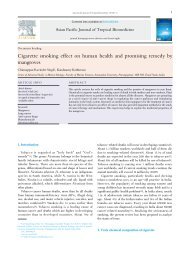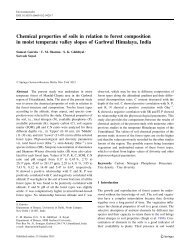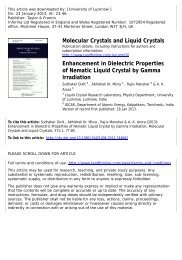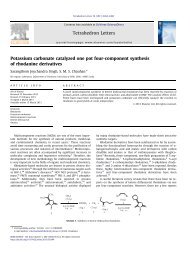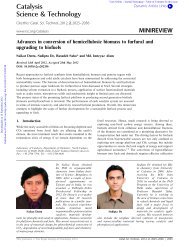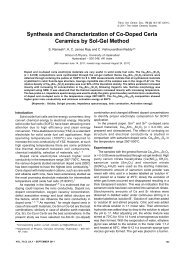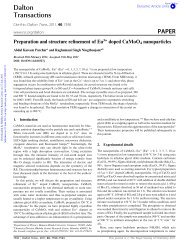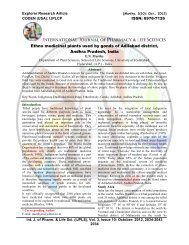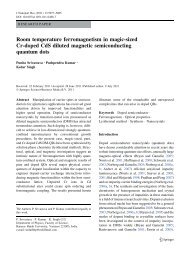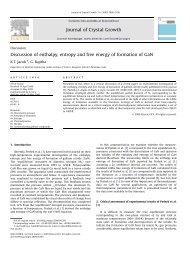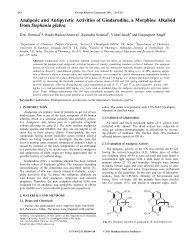Sr2TiO4, Sr3Ti2O7, Sr4Ti3O10, and SrTiO3 - Dr. DS Kothari ...
Sr2TiO4, Sr3Ti2O7, Sr4Ti3O10, and SrTiO3 - Dr. DS Kothari ...
Sr2TiO4, Sr3Ti2O7, Sr4Ti3O10, and SrTiO3 - Dr. DS Kothari ...
You also want an ePaper? Increase the reach of your titles
YUMPU automatically turns print PDFs into web optimized ePapers that Google loves.
54 K.T. Jacob, G. Rajitha / J. Chem. Thermodynamics 43 (2011) 51–57FIGURE 2. The st<strong>and</strong>ard Gibbs free energy of formation of SrTiO 3 from itscomponent binary oxides as a function of temperature: —d— (red online), thisstudy; N (blue online), Taylor <strong>and</strong> Schmalzried [24]; <strong>and</strong> —j— (black online),Knacke et al. [25]. (For interpretation of the references in colour in this figurelegend, the reader is referred to the web version of this article.)FIGURE 4. High-temperature heat capacity of SrTiO 3 as a function of temperature:j (blue online), Coughlin <strong>and</strong> Orr [19]; h (red online), Ligny <strong>and</strong> Richet [20];<strong>and</strong> — (black online), selected data, equation (6). (For interpretation of thereferences in colour in this figure legend, the reader is referred to the web versionof this article.)FIGURE 3. The variationtemperature: h (red online),[16] <strong>and</strong> Gallardo et al. [17];selected data. (For interpretationthe reader is referred to<strong>and</strong> Duran et al. [18] arecapacity reassessed in thisLorenson [15] <strong>and</strong> Duranis shown by the continuousat T = 298.15 K obtained0.7) J K 1 mol 1 .The high-temperatureare compared in figure 4.values fall between theture heat capacity data.the equation:C P =ðJ K 1 mol 1 Þ¼137:09676Based on the selectedSrTiO 3 are evaluated <strong>and</strong>analysis of the st<strong>and</strong>ardstudy using the relation,DH fðoxÞ;298:15 ¼ DG fðoxÞ ðTÞ withal.online),legend,heat<strong>and</strong>temperatures,SrTiO 3(109.128 ±[19,20]selectedlow-tempera-byð6Þfor‘‘third-law”thiswhere DG fðoxÞ ðTÞ ¼DG rð4Þ ðTÞ is the st<strong>and</strong>ard Gibbs free energy of formation of SrTiO 3from its component binary oxides, <strong>and</strong> DðH TH 298:15 Þ <strong>and</strong> DðS TS 298:15 Þ representsthe difference of P ðH TH 298:15 Þ <strong>and</strong> P ðS TS 298:15Þ between products <strong>and</strong> reactants,each multiplied by the appropriate stoichiometric coefficient. For assessing the entropyof formation of SrTiO 3 from binary oxides at 298.15 K, <strong>DS</strong> fðoxÞ;298:15, <strong>and</strong> valuesof DðH TH 298:15 Þ <strong>and</strong> DðS TS 298:15 Þ, auxiliary data on SrO <strong>and</strong> TiO 2 (rutile) are takenfrom NIST-JANAF tables [23]. Using the selected st<strong>and</strong>ard entropy of SrTiO 3 at298.15, the st<strong>and</strong>ard entropy of formation from binary oxides <strong>DS</strong> fðoxÞ;298:15 ¼3:314 0:863J K 1 mol 1 The results of the ‘‘third-law” analysis are displayed infigure 5, where the value of enthalpy of formation calculated from values of free energyof formation at different temperatures is plotted against the temperature of thefree energy measurement. Considering the uncertainty in the data used for the analysis,the enthalpy of formation is essentially constant, DH fðoxÞ;298:15 ¼ 116:5070:9 kJ mol 1 . The uncertainty in entropy is the major contributor to the error inthe ‘‘third-law” enthalpy of formation. The small variation of 0.52 kJ mol 1 inDH fðoxÞ;298:15with temperature suggests either a small temperature-dependent errorin EMF or an inaccuracy of 1.3JK 1 mol 1 in entropy of formation. This smalldifference is also reflected in the enthalpy of formation from oxides at T = 298 K obtainedby ‘‘second-law” ðDH fðoxÞ;298:15 ¼ 118:032 0:25 kJ mol 1 Þ <strong>and</strong> ‘‘third-law”ðDH fðoxÞ;298:15 ¼ 116:507 0:9 kJ mol 1 Þ techniques.As shown in figure 5, the value of DH fðoxÞ;298:15obtained from the ‘‘third-law”analysis is in good agreement with the high-temperature solution calorimetricdetermination of Xu et al. [21], but differs significantly from the bomb calorimetricvalue reported by Panfilov <strong>and</strong> Feodosev [22]. Since the data compiled by Knackeet al. [25] for SrTiO 3 is based on the bomb calorimetric value of enthalpy of formation[22], the free energy of formation given in compilation is more negative thanthat obtained in this study as shown in fig. 2. Thus the results of this study stronglysuggest revision of data for SrTiO 3 given by Knacke et al. [25]. Complete data forSrTiO 3 based on the results of this study, assessed heat capacity <strong>and</strong> auxiliary datafor SrO <strong>and</strong> TiO 2 from NIST-JANAF is provided in table 2. The table lists the enthalpy<strong>and</strong> free energy of formation of SrTiO 3 from elements at regular intervals of temperature.The entropy of SrTiO 3 assessed from thermal data at is marginally higher by(1.43)JK -1 mol -1 than the value obtained in this study at T av = 1075 K from EMFmeasurement.The EMF of cell II is related to the st<strong>and</strong>ard Gibbs free energy change for thereactionSrO ðsolidÞþ3SrTiO 3 ðsolidÞ !Sr 4 Ti 3 O 10 ðsolidÞ;ð8ÞDG rð8Þ 98=ðJ mol 1 Þ¼ 2FE II ¼ 43563 þ 3:107ðT=KÞ: ð9ÞAt T = 813 K the value of DG rð8Þ 98 ðJ mol 1 Þ¼ 41037 obtained in this study issubstantially different from the value of ( 90, 374 ± 4, 184) J mol 1 reported byTaylor <strong>and</strong> Schmalzried [24] using a cell similar to that employed in this study,but with polycrystalline SrF 2 electrolyte <strong>and</strong> Pt electrodes. The formation of Sr 4 PtO 6is possible when SrO at relatively high activity is in contact with Pt metal <strong>and</strong> O 2 gas[30,31]. Although the formation of strontium platinum oxides would be retardedconsiderably in the presence of SrF 2 , the possibility of side reactions affecting theEMF remains. Taylor <strong>and</strong> Schmalzried [24] were able to obtain stable EMF only atT = 813 K. The use of Au electrodes in this study was to avoid this potential complication.Further, Taylor <strong>and</strong> Schmalzried [24] could not confirm the presence ofof the low-temperature heat capacity of SrTiO 3Todd <strong>and</strong> Lorenson [15]; s (blue online), Salje et+ (green online), Duran et al. [18]; <strong>and</strong> — (blackof the references in colour in this figurethe web version of this article.)almost invisible in the scale used in figure 3. Thestudy, based on closely agreeing results of Toddet al. [18] <strong>and</strong> consistent with data at highercurve in the figure. The st<strong>and</strong>ard entropy offrom the reassessed heat capacity data isheat capacity values derived from experimentsThe results are in reasonable agreement, <strong>and</strong> thetwo sets of data <strong>and</strong> join smoothly with theThe high-temperature heat capacity can be representedþ 0:00323T 456:79197T 0:5 1195220T 2 :values of C P ðTÞ, values of H T H 298.15 <strong>and</strong> S T S 298.15presented in table 2. These values are used forGibbs free energy of formation of SrTiO 3 measured in
K.T. Jacob, G. Rajitha / J. Chem. Thermodynamics 43 (2011) 51–57 55TABLE 2Thermodynamic properties of solid SrTiO 3 .T/K C P =ðJ K1 mol 1 Þ (H T H 298.15 )/(kJ mol 1 ) S/(J K 1 mol 1 ) DH f =ðkJ mol 1 Þ DG f =ðkJ mol 1 Þ298.16 99.292 0 109.128 1653.290 1568.303300 98.413 0.182 109.736 1653.286 1567.776400 108.079 10.561 139.528 1652.707 1539.345500 113.503 21.661 164.276 1651.763 1511.109600 117.066 33.200 185.304 1650.720 1483.077700 119.653 45.043 203.554 1649.680 1455.219800 121.663 57.112 219.667 1648.680 1427.507900 123.302 69.363 234.095 1648.402 1399.8421000 124.687 81.764 247.160 1647.349 1372.2841100 125.889 94.294 259.101 1654.334 1344.4571200 126.956 106.937 270.101 1658.455 1316.1631300 127.919 119.682 280.302 1658.011 1287.6541400 128.801 132.519 289.815 1657.600 1259.1811500 129.616 145.440 298.729 1657.237 1230.7361600 130.378 158.440 307.119 1656.939 1202.3141700 131.095 171.514 315.045 1793.637 1172.7281800 131.775 184.658 322.557 1791.655 1136.260DH f <strong>and</strong> DG f are the st<strong>and</strong>ard enthalpy <strong>and</strong> Gibbs free energy of formation of SrTiO 3 from elements.be evaluated as (358.207 ± 1.714) J mol 1 K 1 . It would be interesting to measurethe enthalpy of formation <strong>and</strong> heat capacity of Sr 4 Ti 3 O 10 to cross-check data obtainedin this study.A comparison of the st<strong>and</strong>ard Gibbs free energy of formation of Sr 4 Ti 3 O 10 fromits component binary oxides obtained in this study with values reported in the literatureis presented in figure 6. It reveals that the results of this study are far morenegative than the value suggested by Taylor <strong>and</strong> Schmalzried [24], <strong>and</strong> significantlymore positive than the data given in the compilation of Knacke et al. [25]. The averagedifference in free energy of formation of Sr 4 Ti 3 O 10 between the values obtainedin this study <strong>and</strong> Knacke et al. [25] is 33.76 kJ mol 1 .The EMF of cell III is related to the st<strong>and</strong>ard Gibbs free energy change for thereactionSrO ðsolidÞþ2Sr 4Ti 3O 10 ðsolidÞ !3Sr 3Ti 2O 7 ðsolidÞ;ð12ÞDG rð12Þ 42 ðJ mol 1 Þ¼ 2FE III ¼ 39088 þ 0:5673ðT=KÞ: ð13ÞThe st<strong>and</strong>ard Gibbs free energy of formation of Sr 3 Ti 2 O 7 from its componentbinary oxides can be obtained by combining equations (10) <strong>and</strong> (12). For thereactionFIGURE 5. Comparison of the results of ‘‘third-law” analysis of the measured freeenergy of formation of SrTiO 3 with calorimetric determinations of enthalpy offormation: j (black online), Present study (‘‘third-law” analysis); (red online),Xu et al. [21]; <strong>and</strong> — (green online), Panfilov <strong>and</strong> Feodosev [22]. (For interpretationof the references in colour in this figure legend, the reader is referred to the webversion of this article.)3SrO ðsolidÞþ2TiO 2 ðsolidÞ !Sr 3 Ti 2 O 7 ðsolidÞ;ð14ÞDG rð14Þ 190 ðJ mol 1 Þ¼ 285827 þ 10:022ðT=KÞ: ð15ÞThe ‘‘second-law” enthalpy of formation of Sr 3 Ti 2 O 7 from its component binary oxidesat an average temperature T av =1075Kis( 285.827 ± 0.247) kJ mol 1 .AssumingSr 4 Ti 3 O 10 at the working electrode of their cell; the formation of the compound wasassumed based on the quantities of SrCO 3 <strong>and</strong> TiO 2 used in the preparation of theelectrode by heating the mixture at T = 1973 K for 3.6 ks. According to the resultsof this study discussed later, the only two oxide phases stable at this temperatureare SrTiO 3 <strong>and</strong> Sr 2 TiO 4. The higher chemical potential of SrO suggested by the measurementsof Taylor <strong>and</strong> Schmalzried [24] on cell II is indicative of either incompleteformation of Sr 4 Ti 3 O 10 or formation of ternary oxides richer in SrO [24]. In view ofthese uncertainties in the earlier measurement [24], the data obtained in this studyis considered to be more reliable. The st<strong>and</strong>ard Gibbs free energy of formation ofSr 4 Ti 3 O 10 from its component binary oxides can be obtained by combining equations(4) <strong>and</strong> (8). For the reaction4SrO ðsolidÞþ3TiO 2 ðsolidÞ !Sr 4 Ti 3 O 10 ðsolidÞ;ð10ÞDG rð10Þ 284=ðJ mol 1 Þ¼ 409197 þ 14:749ðT=KÞ: ð11ÞThe stability of the compound, relative to the binary oxides, decreases with temperature.The ‘‘second-law” enthalpy of formation of Sr 4 Ti 3 O 10 from its component binaryoxides at an average temperature of 1075 K is ( 409.197 ± 0.37) kJ mol 1 . If theNeumann–Koop rule is used to estimate the heat capacity of Sr 4 Ti 3 O 10 , then its st<strong>and</strong>ardenthalpy of formation at T = 298.15 K from component binary oxides wouldalso be the same as that at high temperature. Combining with data for SrO <strong>and</strong>TiO 2 [23], the st<strong>and</strong>ard enthalpy of formation of Sr 4 Ti 3 O 10 from elements atT = 298.15 K is ( 5611.598 ± 13.769) kJ mol 1 . Similarly, from the ‘‘second-law” entropychange for reaction (10), the st<strong>and</strong>ard entropy of Sr 4 Ti 3 O 10 at T = 298.15 K canFIGURE 6. The st<strong>and</strong>ard Gibbs free energy of formation of Sr 4 Ti 3 O 10 from itscomponent binary oxides: —d— (red online), this study; N (blue online), Taylor <strong>and</strong>Schmalzried [24]; <strong>and</strong> —j— (black online), Knacke et al. [25]. (For interpretation ofthe references in colour in this figure legend, the reader is referred to the webversion of this article.)
56 K.T. Jacob, G. Rajitha / J. Chem. Thermodynamics 43 (2011) 51–57Neumann–Koop rule to estimate the heat capacity of Sr 3 Ti 2 O 7 <strong>and</strong> combining withdata for SrO <strong>and</strong> TiO 2 [23], the st<strong>and</strong>ard enthalpy of formation of Sr 3 Ti 2 O 7 from elementsat T = 298.15 K is ( 3951.441 ± 10.239) kJ mol 1 . There has been no previousmeasurement of either the Gibbs free energy or enthalpy of formation of Sr 3 Ti 2 O 7 .From the ‘‘second-law” entropy change for reaction (14), the st<strong>and</strong>ard entropy ofSr 3 Ti 2 O 7 at T = 298.15 K can be evaluated as (257.122 ± 1.268) J mol 1 K 1 .The EMF of cell IV is related to the st<strong>and</strong>ard Gibbs free energy change for thereactionSrO ðsolidÞþSr 3 Ti 2 O 7 ðsolidÞ !2Sr 2 TiO 4 ðsolidÞ;ð16ÞDG rð16Þ 90 ðJ mol 1 Þ¼ 2FE IV ¼ 32943 2:482ðT=KÞ: ð17ÞThe st<strong>and</strong>ard Gibbs free energy of formation of Sr 2 TiO 4 from its component binaryoxides can be obtained by combining equations (14) <strong>and</strong> (16). For the reaction2SrO ðsolidÞþTiO 2 ðsolidÞ !Sr 2 TiO 4 ðsolidÞ;ð18ÞDG rð18Þ 110 ðJ mol 1 Þ¼ 159385 þ 3:77ðT=KÞ: ð19ÞFigure 7 compares the results obtained in this study with values from the compilationof Knacke et al. [25]. The results of this study are more negative. The differencebetween the two data sets increases with temperature. The mean difference betweenthe two sets is 4.32 kJ mol 1 .The ‘‘second-law” enthalpy of formation of Sr 2 TiO 4 from its component binaryoxides at an average temperature T av = 1075 K is ( 159.38 ± 0.137) kJ mol 1 . Combiningthe measured enthalpy increments of Sr 2 TiO 4 [19] with data for SrO <strong>and</strong> TiO 2[23], the ‘‘second-law” enthalpy of formation at T = 298.15 K is obtained as( 152.376 ± 0.185) kJ mol 1 . The corresponding st<strong>and</strong>ard enthalpy of formationof Sr 2 TiO 4 from elements at T = 298.15 K is ( 2281.195 ± 6.78) kJ mol 1 . The ‘‘second-law”entropy change for reaction (18) is ( 3.77 ± 0.13) J mol 1 K 1 at T av =1075 K, <strong>and</strong> (6.182 ± 0.17) J mol 1 K 1 at T = 298.15 K. The corresponding st<strong>and</strong>ardentropy of Sr 2 TiO 4 at T = 298.15 K can be evaluated as (167.518 ±0.858) J mol 1 K 1 . It would be useful to confirm this value by low-temperatureheat capacity measurements. The reasonably good agreement between the calorimetricallyderived entropy <strong>and</strong> that obtained from EMF measurement for SrTiO 3 ,gives confidence in the value of entropy of Sr 2 TiO 4 obtained in this study. A thermodynamicdata table for Sr 2 TiO 4 , composed from derived values of enthalpy of formation<strong>and</strong> st<strong>and</strong>ard entropy of Sr 2 TiO 4 at T = 298.15 K <strong>and</strong> high-temperature heatcontent data available [19] in the literature, is displayed as table 3. Correspondingdata tables for Sr 4 Ti 3 O 10 <strong>and</strong> Sr 3 Ti 2 O 7 are not presented since there is no experimentaldata on heat capacity or heat content of these compounds; estimates ofthe st<strong>and</strong>ard entropy <strong>and</strong> enthalpy of formation at T = 298.15 K given in this paperare based on the Neumann–Koop rule.The enthalpy, entropy <strong>and</strong> Gibbs free energy of mixing for the system (SrO +TiO 2 )atT = 1200 K is shown as a function of composition in figure 8. The minimumvalue of enthalpy <strong>and</strong> Gibbs free energy of mixing occurs at the equimolar compositioncorresponding to the compound SrTiO 3 . It is seen that the compoundsSr 4 Ti 3 O 10 ,Sr 3 Ti 2 O 7 , <strong>and</strong> Sr 2 TiO 4 are only marginally more stable than mixtures ofSrTiO 3 <strong>and</strong> SrO corresponding to these compositions. This explains why it is relativelyeasy to synthesize single phase SrTiO 3 from component oxides, but rather difficultto prepare pure phases of Sr 4 Ti 3 O 10 ,Sr 3 Ti 2 O 7 , <strong>and</strong> Sr 2 TiO 4 . The shape of theFIGURE 7. The st<strong>and</strong>ard Gibbs free energy of formation of Sr 2 TiO 4 from itscomponent binary oxides: —d— (red online), this study; <strong>and</strong> —j— (black online),Knacke et al. [25]. (For interpretation of the references in colour in this figurelegend, the reader is referred to the web version of this article.)FIGURE 8. Composition dependence of s (blue online), the enthalpy; –h–(red online), entropy; <strong>and</strong> —N— (black online), Gibbs free energy of mixing at1200 K for the system (SrO + TiO 2 ). (For interpretation of the references in colour inthis figure legend, the reader is referred to the web version of this article.)TABLE 3Thermodynamic properties of solid Sr 2 TiO 4 .T/K C P =ðJ K1 mol 1 Þ (H T H 298.15 )/(kJ mol 1 ) S/(J K 1 mol 1 ) DH f =ðkJ mol 1 Þ DG f =ðkJ mol 1 Þ298.16 143.684 0 167.518 2281.195 2166.429300 143.984 0.266 168.408 2281.184 2165.718400 155.089 15.288 211.546 2280.177 2127.366500 161.092 31.121 246.853 2278.857 2089.314600 165.087 47.441 276.596 2277.543 2051.531700 168.134 64.108 302.282 2276.340 2013.959800 170.675 81.051 324.903 2275.274 1976.550900 172.922 98.233 345.138 2275.641 1939.1171000 174.987 115.630 363.465 2274.357 1901.8001100 176.933 133.226 380.235 2288.967 1863.8711200 178.798 151.014 395.711 2293.663 1825.0751300 180.605 168.984 410.094 2293.732 1786.0201400 182.371 187.133 423.543 2293.762 1746.9641500 184.106 205.457 436.185 2293.763 1707.9081600 185.818 223.954 448.121 2293.748 1668.8531700 187.512 242.620 459.437 2567.561 1627.4401800 189.192 261.456 470.203 2563.831 1572.243DH f <strong>and</strong> DG f are the st<strong>and</strong>ard enthalpy <strong>and</strong> Gibbs free energy of formation of Sr 2 TiO 4 from elements.
K.T. Jacob, G. Rajitha / J. Chem. Thermodynamics 43 (2011) 51–57 57enthalpy curve suggests that all the four compounds would be thermodynamicallystable at low temperatures. The entropy of mixing has a mild negative value for thefour compositions. The results of this study when extrapolated to higher temperaturessuggests the solid-state decomposition of Sr 4 Ti 3 O 10 to a mixture of SrTiO 3 <strong>and</strong>Sr 3 Ti 2 O 7 at T = 1764 ± 9 K, <strong>and</strong> the decomposition of Sr 3 Ti 2 O 7 to a mixture of SrTiO 3<strong>and</strong> Sr 2 TiO 4 at T = 1925 ± 10 K.4. ConclusionsAccurate values for the st<strong>and</strong>ard Gibbs free energies of formationof solid SrTiO 3 ,Sr 4 Ti 3 O 10 ,Sr 3 Ti 2 O 7 , <strong>and</strong> Sr 2 TiO 4 from componentbinary oxides were determined in the temperature range(900 to 1250) K. Used for the measurements were solid-state electrochemicalcells incorporating single crystal SrF 2 as the electrolyte,gold electrodes <strong>and</strong> pure SrO as the reference electrode <strong>and</strong>operated under pure oxygen at ambient pressure. The referencestate for TiO 2 is the rutile form. The free energy of formation ofSrTiO 3 obtained in this study is in good agreement with directmeasurement of Taylor <strong>and</strong> Schmalzried [24], but differs from thatgiven in the compilation of Knacke et al. [25]. The enthalpy of formationof SrTiO 3 obtained in this study agrees with solution calorimetricmeasurements of Xu et al. [21], but differs significantlyfrom the bomb calorimetric studies of Panfilov <strong>and</strong> Feodosev[22]. The incorrect values of free energy of SrTiO 3 in the compilationof Knacke et al. [25] result from the wrong selection of enthalpyof formation based on bomb calorimetry. The entropy offormation of SrTiO 3 obtained in this study is consistent with heatcapacity data available in the literature.For Sr 4 Ti 3 O 10 values for the st<strong>and</strong>ard Gibbs free energy of formationobtained in this study are substantially more negative thanthe value suggested by Taylor <strong>and</strong> Schmalzried [24], <strong>and</strong> significantlymore positive than values given in the compilation ofKnacke et al. [25]. For Sr 3 Ti 2 O 7 results of this study provide newinformation on Gibbs free energy, enthalpy <strong>and</strong> entropy of formation,which are not available in the literature. The values of st<strong>and</strong>ardGibbs free energy of formation obtained in this study forSr 2 TiO 4 are significantly more negative than those given in thecompilation of Knacke et al. [25]. In summary, data for strontiumtitanates given in the compilation of Knacke et al. [25] require majorrevision. New tabulated data for SrTiO 3 are presented. For theother strontium titanates values of enthalpy of formation from elements<strong>and</strong> st<strong>and</strong>ard entropy at T = 298 K are evaluated based onthe results obtained the present study. For a more accuratedescription of thermodynamic properties of Sr 4 Ti 3 O 10 <strong>and</strong> Sr 3 Ti 2 O 7 ,experimental data of on both low- <strong>and</strong> high-temperature heatcapacities are required. For Sr 2 TiO 4 , low-temperature heat capacitymeasurements can confirm the value of st<strong>and</strong>ard entropy derivedin this study. The new data generated in this study would be usefulfor calculation of phase diagrams of higher order systems containingthe binary (SrO + TiO 2 ).AcknowledgementsK.T. Jacob is grateful to the Indian National Academy of Engineering,New Delhi, for the award of INAE Distinguished Professorship.G. Rajitha thanks the University Grants Commission of Indiafor the award of <strong>Dr</strong>. D.S. <strong>Kothari</strong> Postdoctoral Fellowship.References[1] Z. Wu, M. Cao, H. Yu, Z. Yao, D. Luo, H. Liu, J. Electroceram. 21 (2008) 210–213.[2] K.C. Chiang, C.-C. Huang, G.L. Chen, W.J. Chen, H.L. Kao, Y.-H. Wu, A. Chin, S.P.McAlister, IEEE Trans. Electron. Dev. 53 (2006) 2312–2319.[3] M. Fujimoto, W.D. Kingery, J. Am. Ceram. Soc. 68 (1985) 169–173.[4] H. Yamada, G.R. Miller, J. Solid State Chem. 6 (1973) 169–177.[5] N.H. Chan, R.K. Sharma, D.M. Smyth, J. Electrochem. Soc. 128 (1981) 1762–1769.[6] M. Fleischer, H. Meixner, C. Tragut, J. Am. Ceram. Soc. 75 (1992) 1666–1668.[7] K. Domen, A. Kudo, T. Onishi, J. Catal. 102 (1986) 92–98.[8] W. Kwestroo, H.A.M. Paping, J. Am. Ceram. Soc. 42 (1959) 292–299.[9] G.J. McCarthy, W.B. White, R. Roy, J. Am. Ceram. Soc. 52 (1969) 463–467.[10] R.J.D. Tilley, J. Solid State Chem. 21 (1977) 293–301.[11] Z.F. Wei, X.L. Chen, F.M. Wang, W.C. Li, M. He, Y. Zhang, J. Alloys Compd. 327(2001) L10–L13.[12] S.N. Ruddlesden, P. Popper, Acta Cryst. 11 (1958) 54–55.[13] S.N. Ruddlesden, P. Popper, Acta Cryst. 10 (1957) 538–539.[14] M.M. Elcombe, E.H. Kisi, K.D. Hawkins, T.J. White, P. Goodman, S. Matheson,Acta Cryst. B47 (1991) 305–314.[15] S.S. Todd, R.E. Lorenson, J. Am. Chem. Soc. 74 (1952) 2043–2045.[16] E.K.H. Salje, M.C. Gallardo, J. Jimenez, F.J. Romero, J. del Cerro, J. Phys.: Condens.Matter 10 (1998) 5535–5543.[17] M.C. Gallardo, R. Burriel, F.J. Romero, F.J. Gutierrez, E.K.H. Salje, J. Phys.:Condens. Matter 14 (2002) 1881–1886.[18] A. Duran, F. Morales, L. Fuentes, J.M. Siqueiros, J. Phys.: Condens. Matter 20(2008) 0852191–0852196.[19] J.P. Coughlin, R.L. Orr, J. Am. Chem. Soc. 75 (1953) 530–531.[20] D. Ligny, P. Richet, Phys. Rev. B 53 (1996) 3013–3022.[21] H. Xu, A. Navrotsky, Y. Su, M.L. Balmer, Chem. Mater. 17 (2005) 1880–1886.[22] B.I. Panfilov, N.N. Feodosev, Zh. Neorg. Khim. 11 (1966) 2685–2692.[23] M.W. Chase Jr., NIST-JANAF Thermochemical Tables, fourth ed., J. Phys. Chem.Ref. Data Monograph No. 9, American Institute of Physics, Woodbury, NY,1998.[24] R.W. Taylor, H. Schmalzried, J. Phys. Chem. 68 (1964) 2444–2449.[25] O. Knacke, O. Kubaschewski, K. Hesselmann (Eds.), ThermochemicalProperties of Inorganic Substances, Springer-Verlag Publishing, Heidelberg<strong>and</strong> Verlag Stahleisen mbH, Dusseldorf, 1991.[26] K.T. Jacob, K.P. Abraham, J. Chem. Thermodyn. 41 (2009) 816–820.[27] M. Allibert, C. Chatillon, K.T. Jacob, R. Lourtau, J. Am. Ceram. Soc. 64 (1981)307–314.[28] K.T. Jacob, K.P. Abraham, S. Ramach<strong>and</strong>ran, Metall. Trans. B 21B (1990) 521–527.[29] K.T. Jacob, K.P. Jayadevan, J. Mater. Res. 13 (1998) 1905–1918.[30] J.J. R<strong>and</strong>all, R. Ward, J. Am. Chem. Soc. 81 (1959) 2629–2631.[31] L. Ben-Dor, J.T. Suss, S. Cohen, J. Cryst. Growth 64 (1983) 395–396.JCT 10-144


